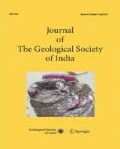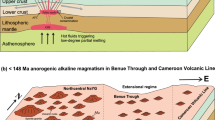Abstract
Outcrop of wad, about 3–5 m thick, associated with low to medium-grade manganese ore deposits in Iron Ore Group (IOG), is present in large quantum in Bonai-Keonjhar belt, Orissa. It is often inter-bedded with volcanic ash layers. Wad is powdery, fine grained, black to blackish-brown in colour, very soft, readily soils the fingers and its hardness on the Mohs’ hardness scale is 1–3. The wad zone is capped by a thin lateritic zone and overlies manganese ore beds of variable thickness in Dalki, Guruda and Dubna mines. Wad constitutes two mineral phases, viz. manganese oxides (δ-MnO2, manganite, romanechite with minor pyrolusite) and iron oxides (goethite/limonite and hematite) with minor clay and free quartz. Mixed limonite-clay and cryptomelane-limonite are commonly observed. Under microscope the ore appears oolitic, pisolitic, elipsoidal to globular in shape having small detritus of quartz, pyrolusite / romanechite and hematite at the core. The ore contains around 23% Mn and 28% Fe with ∼7% of combined alumina and silica. Wad might have developed in a swampy region due to slow chemical precipitation of Fe-Mn-Co enriched fluid, nucleating over quartz/hematite grains. Influence of a marine environment is indicated from δ-MnO2 phase. Remnants of some microfossils, like algal filament, bacteria, foraminifera and diatomite are observed in wad sample under SEM. These microorganisms might have been responsible for the oxidation of dissolved Mn2+ and Fe2+ precipitates. These findings suggest biochemogenic origin of wad in Bonai-Keonjhar belt of Orissa.
Similar content being viewed by others
References
Canterford, J.H. (1984) Cobalt extraction and concentration from manganese wad by leaching and precipitation, Hydrometallurgy, v.12(3), pp.335–354.
Greene, A.C. and Madgwick, J.C. (1991) Microbial formation of manganese oxide, Applied and Environmental Microbiology, v. 57(4), pp.1114–1120.
Hanson, G. (1932) Manganese deposits of Canada. Canada Department of Mines, Geological Survey, Econ. Geol. Series, 120 p.
Hariya, Y. and Kikuchi, T. (1964) Precipitation of manganese by bacteria in mineral springs. Nature, v.202, pp.416–417.
Maithy P.K., Kumar, S and Babu, R. (1998) Biological remains and Organo-sedimentary structures from Iron Ore Group, Barbil area, Orissa. Proc. Int.Sem., Precambrian Crust in Eastern and Central India, IGCP-368, Bhubaneswar, pp.98–105.
Mita, N., Mauyama, A., Usui, A., Hitgashihara, T. and Hariya, Y (1994) A growing deposits of hydrous manganese oxide produced by microbial mediation at a hot spring, Japan. Geo chemical Jour., v.28, pp.71–80.
Mita, N. and Miura, H. (2003) Evidence of microbial formation of manganese wads at the Asahidake hot spring in Hokkaido, Japan. Resource Geol., v.53, pp.233–238.
Miura, H., Wada, K. and Katsui, Y. (2004) Tephrochrono-logy and diagenesis of the manganese wad deposit at the Akan Yunotaki hot spring, Hokkaido, Japan, Jour. Mineral. Petrol. Sci., v.99(6), pp.368–374.
Mohapatra, D., Mishra, D., Roy, G.C. and Das, R.P. (2006) Effect of dissolved organic matter on the adsorption and stability of As(V) on manganese wad, Separation and Purification Technology, v.49, pp.223–229.
Nealson, K.H. and Tebo, B. (1980) Structural fearures of manganese precipitating bacteria. Origin of Life, v.10, pp.117–126.
Pack, A., Gutzmer, J., Beukes, N.J, Van Niekerk, H.S. and Hoernes, S. (2000), Supergene Ferromanganese Wad Deposits Derived from Permian Karoo Strata along the Late Cretaceous-Mid-Tertiary African Land Surface, Ryedale, South Africa. Econ. Geol., v.95, pp.203–220.
Uglow, W.L. (1920) Bog manganese deposits, Dawson Settlement, Albert County, New Brunswick. Unpublished Report, Canadian Munitions Research Commission.
Usui, A., and Mita, N. (1995) Geochemistry and mineralogy of a modern buserite from a hot spring in Hokkadio, Japan. Clay Minerals, v.43, pp.116–127.
Webb, T.C. (2008) Manganese, New Brunswick Department of Natural Resources; Minerals, Policy and Planning Division, Mineral Commodity Profile No. 1, pp. 1–8.
Author information
Authors and Affiliations
Rights and permissions
About this article
Cite this article
Mohapatra, B.K., Mishra, S. & Singh, P.P. Biogenic wad in Iron Ore Group of rocks of Bonai-Keonjhar belt, Orissa. J Geol Soc India 80, 89–95 (2012). https://doi.org/10.1007/s12594-012-0121-0
Received:
Accepted:
Published:
Issue Date:
DOI: https://doi.org/10.1007/s12594-012-0121-0




